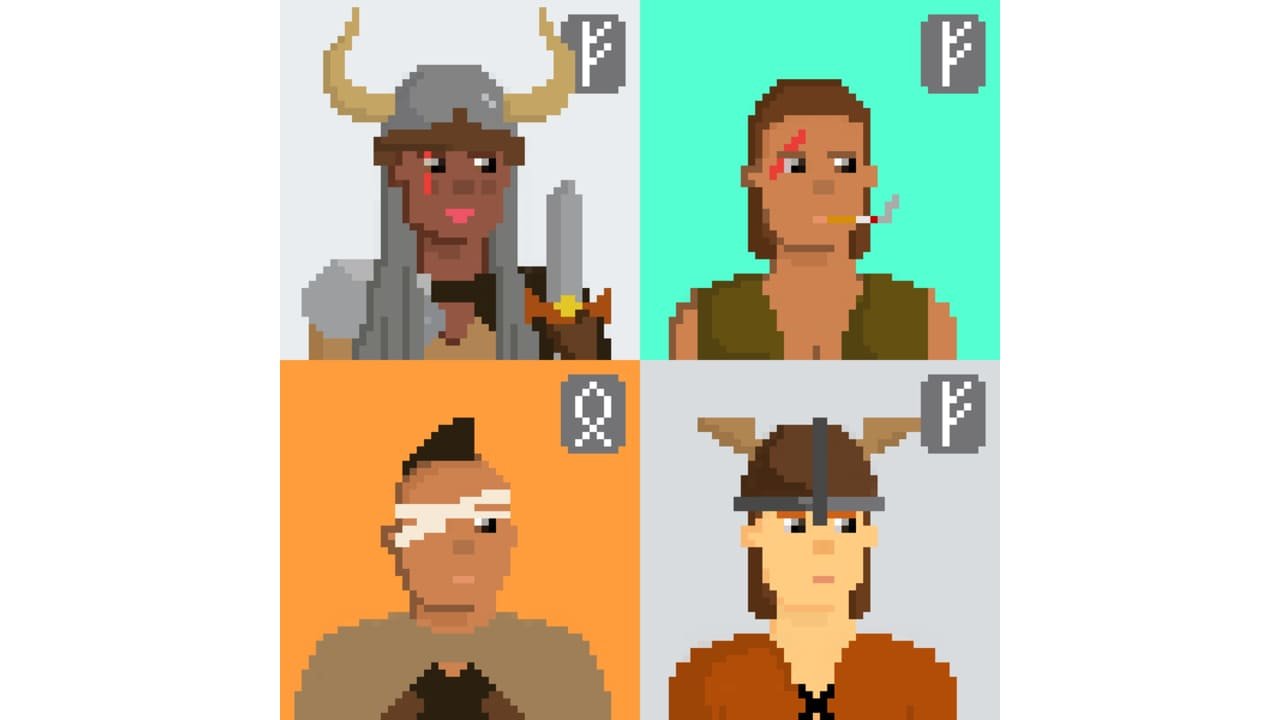What is NFT?
NFT means non-fungible token. A non-fungible item is a single item that is not interchangeable (which means non-exchangeable token). For example, money is fungible, we can exchange Euros, Dollars or cryptocurrencies, but a work of art is non-fungible because it is unique.
An NFT refers to a digital file to which a digital certificate of authenticity has been attached. More precisely, the NFT is a cryptographic token stored on a blockchain. The digital file alone is fungible, whether it is a photo, video or otherwise, the associated NFT is non-fungible.
The first NFT was created in 2014, but NFTs didn’t really hit the mainstream until 2017, when the Ethereum platform gained momentum. It is on this blockchain that the CrytoPunks and CryptoKitties projects (using NFTs) were born. In 2021, Everydays – The First 5000 Days, by artist Mike Winkelmann, better known as Beeple, sold for $69.3 million. It is to date the most expensive piece of digital art in history.
What is an NFT used for?
An NFT makes a digital file unique. In fact, when you buy an NFT you buy exclusive ownership of the original work included in this NFT. However, the artist retains his copyright and reproduction rights. The buyer acquires certain rights such as publishing the work online. An NFT can be associated with:
- Digital painting.
- Video, such as NBA Top Shot basketball videos.
- A meme.
- Photograph.
- Collector’s item, a card for example.
- Video game element (avatars, skins), such as those of Cryptokitties.
- Ticket for an event, such as a concert.
- Movie.
- Patent.
- Virtual object that can be used in a virtual world with a virtual reality headset, such as a pair of designer shoes.
- Audio file, or even a whole musical album like “When you see yourself” by the group King of Leon.
For an artist, an NFT makes it possible to sell a digital file as he would sell a physical work. For a buyer, the NFT makes it possible to support an artist, to collect digital works of art and to speculate on these works.
NFTs the future of the art world – when the canvas becomes a gallery
It is a booming market. On the net, NFTs, these digital works of art, see their value constantly multiplied.
Sold for millions of dollars, and often created by artists unknown to the battalion, they more than compete with the traditional art market, and are on the way to becoming essential.
A digital revolution
It all starts in 2015. The Etheria project offered to buy plots of a virtual world. The success is such that NFTs are multiplying, until the recent transaction of Mike Winkelmann who sold one of his virtual works for nearly 70 million dollars in cryptocurrency. The question then arises, who would want to pay to buy a work that is virtually non-existent and available to everyone? To understand, you have to start from the beginning. In the past, it was possible to duplicate any digital file, it was enough to make a copy paste. Each video, piece of music, image, therefore had virtually no value because no original copy existed.
For artists, this posed a real problem in terms of the value of their creations, but also the lack of profit they generated. Blockchain technology then revolutionized everything, making it possible to stamp digital files with an authenticity marker that is impossible to falsify, and which therefore corresponds in the tangible world to a title deed.
This is how NFTs work. If it is still possible to copy it, it is however impossible to hold the original copy if you have not purchased it, its presence on the blockchain making it tamper-proof, but also unique. And in fact, its value increases significantly.
To compare to a tangible object, an NFT is like a photograph: it can be duplicated endlessly, but only a photo identified and marked by its photographer will be considered authentic. For artists at the origin of digital works, whether visual art or music, it is then sufficient to pay around $50 in cyrpto currency to transform their file into a unique NFT, but above all now the holder of tangible value.

A virtual future for art?
This NFT revolution then completely changed the game for digital artists. Finally, their works have value and can generate a profit. Why then do collectors decide to invest in digital and therefore non-tangible works? Simply because they have the guarantee of the uniqueness of the virtual object held on the blockchain. This is good news for artists, but it is also a field that has become more lucrative.
Now, gifs, video clips, memes, and tweets are selling in cryptocurrency for the equivalent of several hundred thousand dollars. The most impressive transaction to date remains that carried out by Mike Winkelmann, known by his artist name Beeple, with his digital work “Everyday – The first 5000 days” sold for the modest sum of 70 million dollars. It should be noted at the same time that the artist had never managed to sell one of his printed, and therefore tangible, works for more than $100. The future of webs may then be on the web.
NFT monkey | Bored Ape Yacht Club (BAYC): the identity of the creators of the stars’ favorite NFTs revealed
No better day to ingest the M1/M2 Serums other than on Mutant Monday!! First full set completed ? @BoredApeYC #BAYC #MAYC pic.twitter.com/enTgMXHvcP
— sumit.eth ? (@sumit_eth) February 7, 2022
Their images of monkeys populate the social networks of celebrities like Justin Bieber or Paris Hilton. The identity of the founders of the “Bored Ape Yacht Club” (BAYC), a collection of several thousand images of monkeys sold in Non Fungible Token.
Solano and Aronow are behind the BAYC NFTs of cartoonised anthropomorphic apes.
“You’re not just buying an avatar or a rare piece of art. You have a membership card for a club whose benefits and offers will increase over time,” the Bored Ape Yacht Club site promises. This idea of a closed circle, reserved for people who have at least one of the 10,000 Bored Apes in their possession, has seduced several celebrities such as American presenter Jimmy Fallon or rapper Eminem.
Welp, here we go…
Hey, I’m Zeshan. Nice to meet y’all (:
Web2 me vs. Web3 me pic.twitter.com/0AnqurQ1el
— Sass (@SassBAYC) February 8, 2022
Seems like the cat is out of the bag anyway, so…
Hi, I’m Kerem ??
web2 me vs. web3 me pic.twitter.com/v7i4JDCTlc— EmperorTomatoKetchup (@TomatoBAYC) February 8, 2022
NFTs and cryptocurrencies: what are the differences?
The main difference between NFTs and cryptocurrencies is that one is fungible and the other is not. Otherwise, the two “technologies” are very similar in their volatility. Indeed, NFTs and cryptocurrencies are, by nature, speculative and their prices evolve according to supply and demand. The more a cryptocurrency or a series of NFTs is desired, the more its price is likely to soar, especially if the quantities are limited.
Today and in the majority of cases, NFTs are sold on merchant sites such as Opensea or Rarible using cryptocurrencies, the majority of which is Etherum (#ETH). The two technologies are therefore intrinsically linked. To give an example, some NFT projects have such notoriety that their prices have skyrocketed considerably as is the case with the Bored Ape Yacht Club NFTs which, at the time of writing, have an average resale price. of 80 ETH per image, i.e. €220,000 where it was less than 1 ETH at the start of 2021.
NFTs in video games: what is it and what does it involve?
Who says gambling, says dangerous game. As a reminder, an NFT being digitally identifiable and authenticated, this allows an Internet user to acquire digital objects using real money and to be the sole holder. The Internet user can thus freely resell said NFT if he judges the interest or the need for it.
At a time when players are buying more and more cosmetics within games or additional content out of a need for recognition, belonging or performance, the arrival of NFTs in video games is likely to cause a major upheaval. in consumption habits. Indeed, this would allow, for example, a player to buy a unique outfit for his character from a multiplayer game of which he would be the sole owner and potentially allow him to resell it later, again in the form of a NFT, more expensive or conversely cheaper.
The player would therefore inject real money into the game to benefit from a volatile service without being able to really measure his future resale price beforehand. A bit as if he were playing a share on the stock market but within a video game. In all cases, the publisher and the creator of the game in question would receive, regardless of the resale amounts, a commission on the transactions.
While lootboxes within video games have been banned in several countries, NFTs again risk making several administrations cringe, and legislation is currently almost non-existent on this subject. As you will have understood, without safeguards, the excesses are likely to be numerous.
Several publishers and developers have already announced that they want to create NFTs, as was the case for Ubisoft with its project entitled Quartz, GSC Game World and its game S.T.A.L.K.E.R. 2 which was also to receive them or Konami which had declared that it wanted to sell anniversary collectables on the theme of Castlevania. However, the stakes of NFTs being for the moment globally only pecuniary and only really benefiting publishers, the very idea of NFTs within games repels a majority of players. The two studios have also had to deal with a wave of disgruntled players after these announcements.
Pushing Ubisoft to delist its own video from Youtube after more than 30,000 dislikes and GSC Game World to backpedal by canceling the arrival of NFTs in its next title. Conversely, Ubisoft’s stock price skyrocketed shortly after the announcement, and Konami garnered over $160,000 in sales in just a few hours thanks to its Castlevania collectibles. A sign once again that this technological innovation within the video game itself is aimed more at investors than at players.
NFT and web 3.0
To go further, we offer you some thoughts on the future of NFTs which, even today, have not yet revealed their full potential. Many defenders of NFTs sacred this technology as one of the pillars of the so-called web 3.0. Indeed, the web we know today is known as web 2.0 because it allows – broadly – interactions between individuals which was not the case with web 1.0 before 2004 and which only allowed the consultation of elements online without any real possibility of interaction. Web 3.0 aims to be an “embodied” Internet in which the Internet user will no longer be just a simple connection ID on a website but indeed an avatar moving within a virtual universe. This fictional virtual universe is today called the “Metaverse“.
As you will have understood, this name corresponds in all respects with the new name “Meta” of the holding company owning Facebook, Instagram and WhatsApp and it is knowingly that the company has renamed itself thus, laying the bricks of its future foundations and outlining its future directions. Dystopian or utopian, web 3.0 could enable virtual life with an endless array of possibilities as seen in Steven Spielberg’s 2018 film Ready Player One. In a fictional world, virtual possessions could materialize through NFT.
What is impalpable in real life would become so in a Metaverse. Today, there are many initiatives relating to Metaverses and brands are starting to take a serious interest in them, as was the case for Nike, which recently bought the RTFKT studio specializing in the creation of 3D digital collectables for the purpose of creating NFTs. The RTFKT studio has also created its own series of collectable NFTs called CloneX, the possession of which allows you to have access to a virtual apartment in which you can store all your NFT works.
NFT: Ghozali, an Indonesian becomes a millionaire with selfies
Those who think there is absurdity in the rise of the NFT market are unlikely to change their minds with the story of Ghozali Ghozalu. This 22-year-old Indonesian student became a millionaire overnight thanks to a simple batch of selfies.
The young man has indeed converted and sold 1000 selfies in the form of non-fungible tokens (NFT) on the OpenSea sales platform. Having photographed himself regularly for five years, Ghozali originally intended to use the footage for a time-lapse video culminating in his graduation. But, after discovering the blockchain and NFTs, he explained that he changed his plan. Thus, the batch of images was deposited on the OpenSea site – specializing in the purchase and sale of non-fungible tokens -, with a price of around three dollars per photo.
“I never thought anyone would want to buy the selfies,” he said. Still, the project eventually got spotted and demand grew, making him a millionaire. Today, the floor price of an image is 0.25 ETH (ethereum), or 688 euros. Ghozali has even become a minor star in the crypto community. He has more than 40,000 followers on Twitter, and some Internet users appear with clothes bearing his image.
today sold more than 230+
and until now I don’t understand why you want to buy #NFT photos of me !!!but i thank you guys for 5 years of effort paid off pic.twitter.com/nHZJnowCMC
— Ghozali_Ghozalu (@Ghozali_Ghozalu) January 11, 2022
The young Indonesian said he would not offer new NFTs of his selfies and urged owners (currently 503 addresses) not to abuse his images. “I believe in you so please take care of my photos,” he commented. Ghozali plans to invest the money and dreams of opening his own animation studio.
Buy and Sell NFT | | How do I create, buy, trade or sell NFT?
Important information: All investments involve some degree of risk. As a general rule, you should only sell and buy or trade financial products that you are familiar with and understand the risks associated with. You should carefully consider your investment experience, financial situation, investment objectives, level of risk tolerance and consult your independent financial advisor regarding the appropriateness of your situation before making any investment.
Sources: PinterPandai, TokoPinter, The Verge, Art News
Poto ccredt (main photo): TonyMelony / Pixabay



